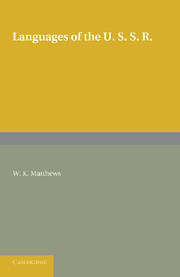Book contents
- Frontmatter
- Contents
- LIST OF ILLUSTRATIONS
- PREFACE
- Map
- Chapter I THE LINGUISTIC PATTERN
- Chapter II PALAEOASIATIG LANGUAGES
- Chapter III URALIAN LANGUAGES
- Chapter IV ALTAIC LANGUAGES
- Chapter V NORTH CAUCASIAN LANGUAGES
- Chapter VI SOUTH CAUCASIAN LANGUAGES
- Chapter VII INDO-EUROPEAN LANGUAGES
- Appendix I TABULAR SUMMARY
- Appendix II LANGUAGE STATISTICS
- Appendix III BIBLIOGRAPHY
- Appendix VI INDEX OF LANGUAGES AND DIALECTS
- Appendix V SYMBOLS AND PHONETIC VALUES
- INDEX
Chapter II - PALAEOASIATIG LANGUAGES
Published online by Cambridge University Press: 05 June 2016
- Frontmatter
- Contents
- LIST OF ILLUSTRATIONS
- PREFACE
- Map
- Chapter I THE LINGUISTIC PATTERN
- Chapter II PALAEOASIATIG LANGUAGES
- Chapter III URALIAN LANGUAGES
- Chapter IV ALTAIC LANGUAGES
- Chapter V NORTH CAUCASIAN LANGUAGES
- Chapter VI SOUTH CAUCASIAN LANGUAGES
- Chapter VII INDO-EUROPEAN LANGUAGES
- Appendix I TABULAR SUMMARY
- Appendix II LANGUAGE STATISTICS
- Appendix III BIBLIOGRAPHY
- Appendix VI INDEX OF LANGUAGES AND DIALECTS
- Appendix V SYMBOLS AND PHONETIC VALUES
- INDEX
Summary
The Palaeoasiatic languages are scattered over the Far Eastern littoral of the U.S.S.R., which reaches across more than twenty degrees of latitude from the intercontinental Bering Strait to Korea and includes the island of Sakhalin. They comprehend a knot of three languages—Chukcha (Luoravetlan), Koryak (Nymylan), and Kamchadal (Itel'men), constituting a single stock and spoken from Chukotka to Kamchatka; Yukagir (Odul), the mother-tongue of fewer than 500 persons in Northern Yakutia; Gilyak (Nivkh), used in North Sakhalin and on the lower Amur; Ainu, spoken in South Sakhalin, which was recently annexed from Japan; and the isolated language of the Yenisei Ostyaks (Kets) in Central Siberia. Some of these languages are separated from one another by intruders of Altaic stock (Yakut and Tungus), and all of them have been variously modified by contact with Russian. Ethnic and linguistic idiosyncrasy have been partly recognised by the Soviet administration, which has subdivided the north-easterly (Anadyr') thrust of the Khabarovsk region (kraj), where the Palaeoasiatic languages are in use, into a Chukcha (northern) and a Koryak (southern) national area (okrug), extending from inner Kamchatka to the Arctic Ocean.
Whether related genealogically or geographically, the Palaeoasiatic languages have common traits, some of which they share with North American (North Amerindian), others with Korean and Japanese. Such considerations have led the Latvian orientalist P. Šmits (Schmidt) to include the last two in his Palaeoasiatic group. These languages, he observes, prefer initial voiceless consonants to voiced ones; final t tends to become r in Yenisei Ostyak, Gilyak, Ainu, and Korean; and there is no f in Chukcha, Koryak, and Yukagir, and perhaps it was missing in the older forms of the Sakhalin vernaculars, Gilyak and Ainu. Like Eskimo and the Indian languages of North America (e.g. Algonkin), though not necessarily to the same extent, the Palaeoasiatic group shows a tendency to various degrees of incorporation, i.e. to crystallise the verb and its associates into a holophrase, or polysynthetic mass (cf. Chuk. gelvulin ‘he got a wild reindeer’ with Greenland Esk. naakisarppaait ‘they used to pity him’). Other peculiarities are: a pattern of vowel harmony, implying a classification of vowels into two contrasted series, the relative scarcity of words with initial voiced consonants, and a system of numeration based on finger and hand.
- Type
- Chapter
- Information
- Languages of the USSR , pp. 3 - 13Publisher: Cambridge University PressPrint publication year: 2013



